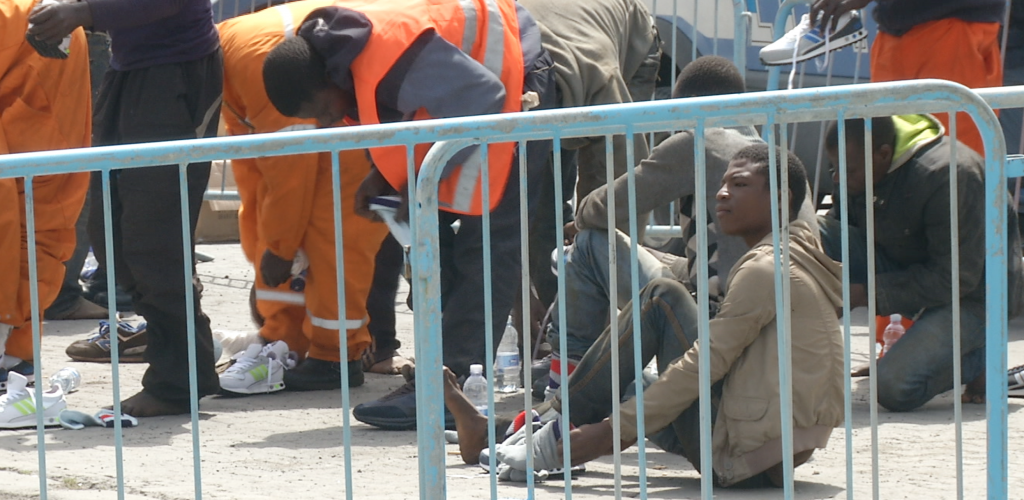
Dear Blog Readers – This is Part II of my Reporter’s Notebook on my recent time in Sicily.
When I was in Sicily recently we did a report for AP Television together with my AP wire and photo colleagues on the sneakers given to the migrants in the Port of Catania, Sicily. For some reason, the AP bosses were rather non-plussed by this story thinking that it is really “nothing new” – but I find it a fascinating combination of Global Issues in a sneaker. There is migration, globalization, illegal workers, mafia, charities, and law enforcement all tied into these sneakers.
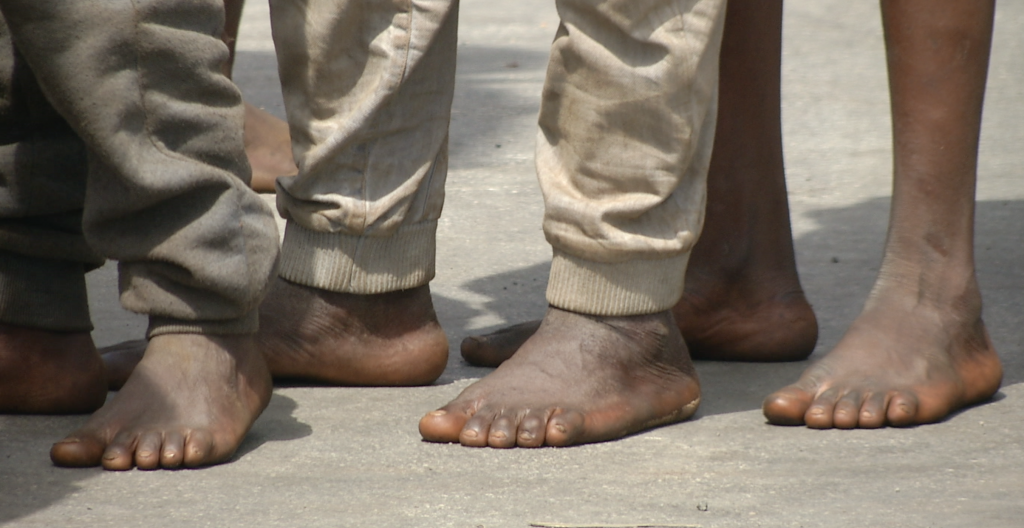
Let me explain.
Months ago as we covered migrants arriving in the ports of Sicily, we noticed that they were immediately given spanking new brand name speakers. Just a half hour off the boat, and the barefoot migrants were clad in shiny white Adidas, Nikes, Hogans and Merrells. Someone asked a border policeman when we were standing around in port filming an arrival one day and he explained that all those shoes are counterfeits that have been confiscated by the police and given to Italian charities to distribute. We all got a kick out of that Italian ingenuity. What better use for confiscated counterfeit shoes than to give them to people who need them.
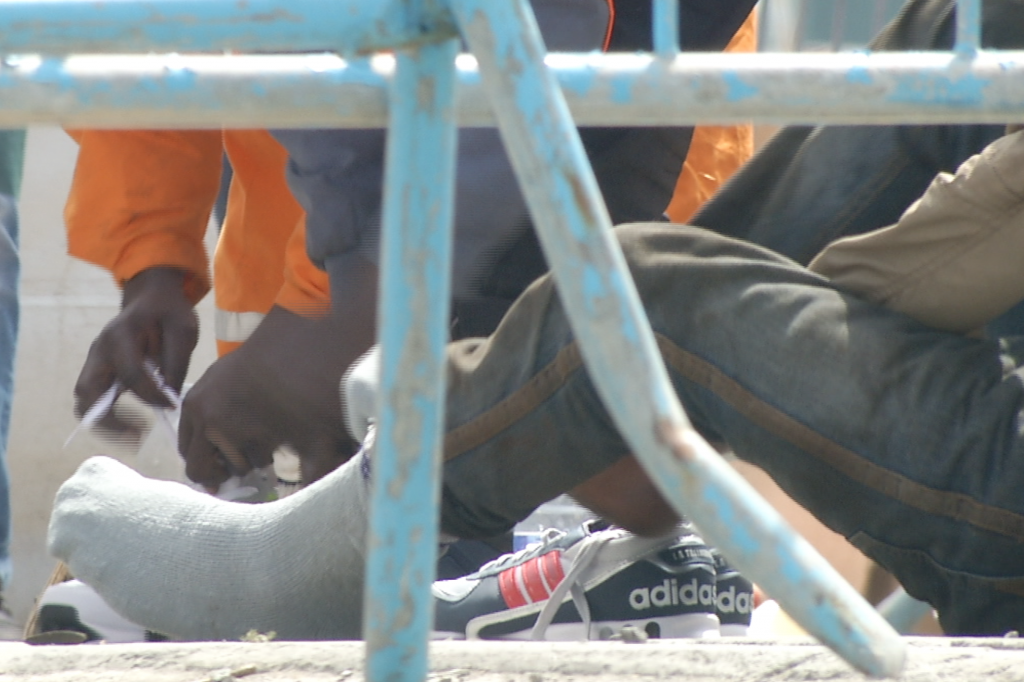
Then we decided to do a little more on the story. All over Catania, Sicily, we found men selling the counterfeit shoes on top of cardboard boxes on street corners, or peddling their wares in their hands in the middle of the city’s sprawling market.
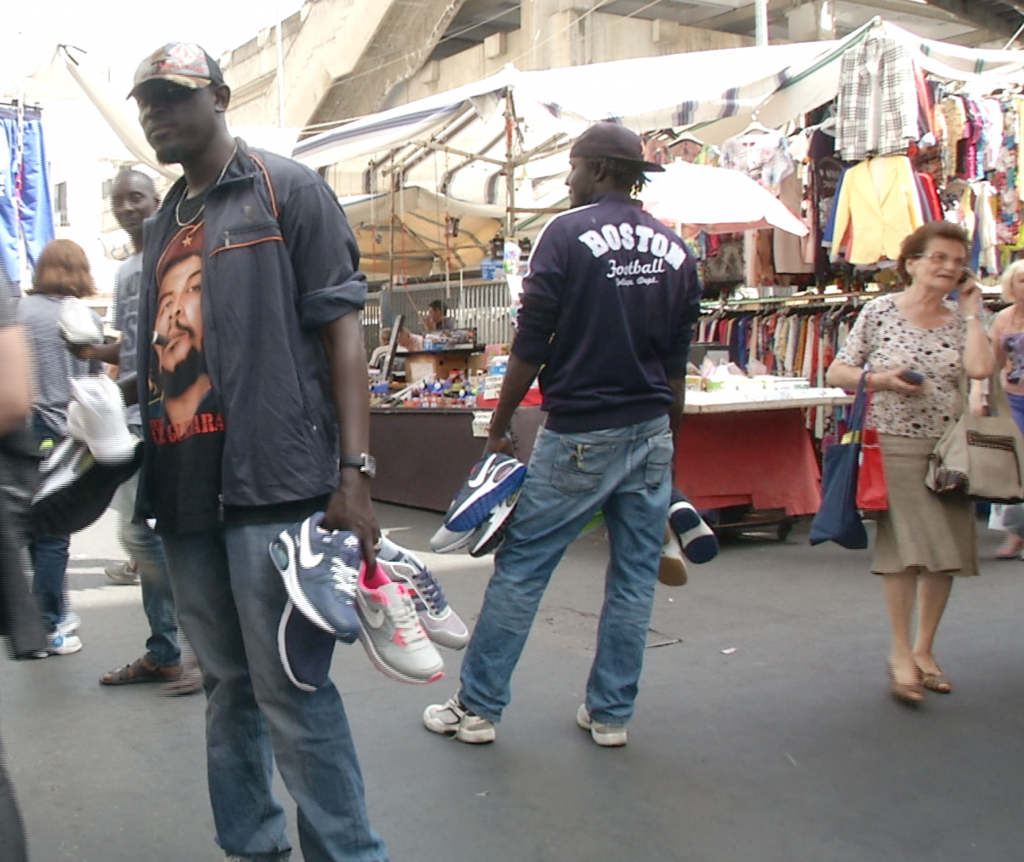
When we tried to film the men selling the shoes, they quickly disappeared, popping up again shortly about 100 meters away. Some of them told us aggressively not to film them.
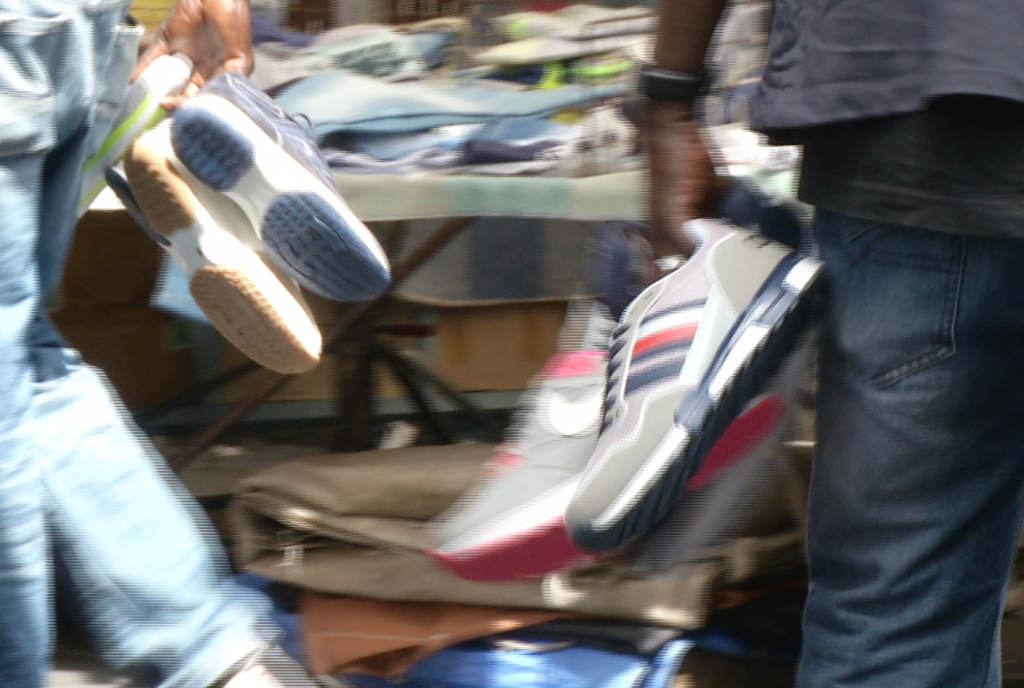
A few days later we went back to the market with General Pietro Belfiore of the Catania local police. He had a team with him that confiscate counterfeit items in the market. He explained the whole business to us. He said the counterfeit shoe sellers that we saw all over Catania are part of a Senegalese gang that sell counterfeit items. The counterfeit sneakers are very popular, especially among Italian teenagers who spend 25-30 euro for a pair. Belfiore estimated that the men selling them on the street make up to 150 euros a day.
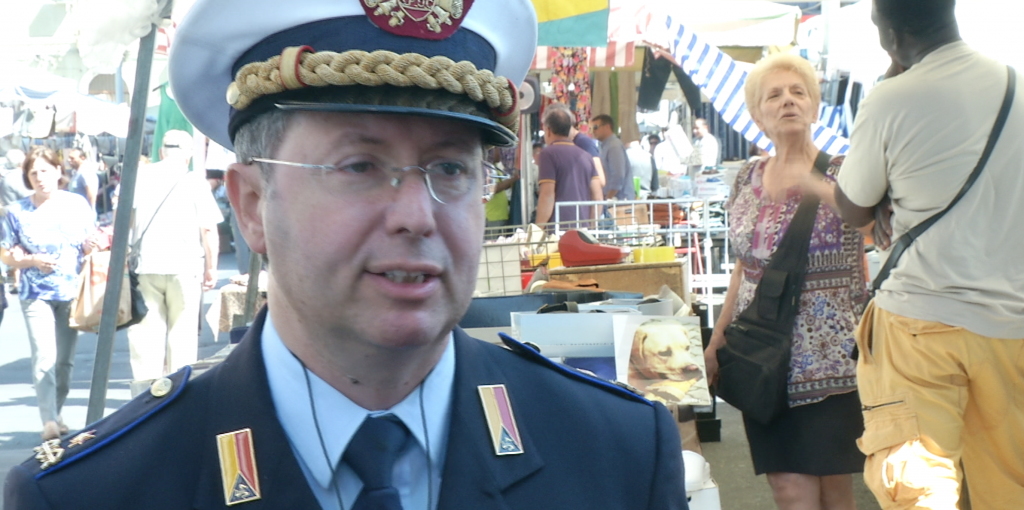
We asked if the Senegalese men selling them on the street were some of the same men who got off the boats in the port a few days earlier. The answer was NO.
Belfiore then gave us his description of the whole chain of production. The counterfeit shoes, he said, are made in the Campania (Naples area) of Italy, by Chinese workers in small illegal factories. They are then sold to a Senegalese criminal group who bring the boxes down to Sicily to be sold on the streets and in the marketplace. All this is done with the approval and perhaps involvement of the Camorra Mafia. Once the counterfeit shoes are in Sicily, they are sold by the Senegalese with the complicit approval of the local Sicilian crime families. Then law enforcement steps in. Belfiore and his men confiscate the shoes and donate them to the Catholic group Caritas. He said in 2014 they confiscated about 4,000 pairs.
When I visited the small Caritas office near the train station in Catania, hardly anyone was there, it was lunchtime. Outside the train station dozens of Eritrean and Sudanese migrants rested on the grass under shady trees. Many of them were wearing their new shoes.
My colleague Gino Macelli went back to speak to the Caritas woman responsible for the shoes and she said so far they have only handed out 400 pairs so far this year, but they are expected to hand out many more.
Coming soon in the Sicily Series: Migrant Workers in Sicily, Traffickers and Terrorists

Intriguing story. This really is reporting at its best; getting behind the apparent story to the real one.
Surprised AP didn’t want it but I’m glad they didn’t so you can bring it to us in greater depth. Can’t wait until the next installment. L/D.
Thanks Dad. Actually AP did use it. I did the TV version and Frank Jordans did the wire version. AP has a lot of space to fill up, so even though they were non-plussed, they still used it. I like to do my little behind-the-scenes version anyway for my blog. Next Sicily installment coming soon, however, I’ve gotten distracted today by a debate that might be interesting to you– top Italian female professors around the world are calling on the President of the University of Rome to step down after he served on a jury to elect Miss University — a contest which involved Italian female university students parading around in bikinis. I am going to be curious to see what happens. Remember when Larry Summers stuck his foot in his mouth about Women mathematicians and had to resign as President of Harvard!
capitalism at work – if something, anything can be commodified, then it will be!
Wow! The circle of trade. The journey of Euros. The shodding of the poor. What you will get if you survive the dangerous boats that take people from Senegal to Libya to Lampedusa to Italy.And what about those Chinese, are they slave labor? Are they legal or illegal immigrants? You know this story could be happening in California or in NYC. Or maybe in London or Paris. The migrations of the poor and desperate, all around the world, are happening despite middle class resistance. What will become of these people, after they get their new sneakers? What a world, what a world!
I agree…what a world! If you want to know more about the poor Chinese workers in the Naples area, you should read the book “Gomorra” about the Camorra (Naples area) Mafia by Roberto Saviano. Many of the Chinese workers are illegal and the Chinese in Italy have very ingenious ways of becoming legal – the book explains. For example, Chinese who have legal documents in Italy never die, when they pass away their legal documents are passed on to someone else who takes on their official identity. An AP colleague did a long report on the horrible conditions at illegal Chinese clothing producing factories in the Prato area of Italy and it was very depressing. A cameraman went with her on a police raid of one of these factories and I edited the video — it was shocking. These workers — even with little babies– live in closet-like, windowless spaces attached to the factory which is filthy dirty. I thought I was going to have an asthma attack (and I don’t suffer from asthma) just looking at the video of the air they breathe –filled with dust balls and cotton floating around. If I had to choose, I would rather be an illegal counterfeit sneaker peddler in the market in Sicily, rather than hunched over a sewing machine in a windowless factory 14 hours a day.
Another interesting story. How heartening to know that good can come out of crime. Hearing that this gang with other “gangs’ ” help controls the shoe selling makes me wonder about other peddlars I have seen in other Italian cities. I suppose some are in set-ups very similar to this one. There are so many items being sold this way by sellers keeping an eye out for the police. My favorite item was a small Barbie-type doll riding a bicycle around and around in the entrance of the Galleria in downtown Naples three years ago..
Thanks for interesting info.
A presto
Thank you Joan — I read an interesting article in the Economist on how must of the Senegalese peddlers are from an ethnic group called the Mourides. I need to do more research on this topic though before I say anything more.
Ingenious indeed! Italy is so complicated yet can be so practical. In the U.S. counterfeit shoes sit in evidence warehouses for years awaiting criminal proceedings only to be destroyed afterwards. Much better to put them to use for the poor. Great little sideline story to the migrant drama!
I agree – no use leaving them in a warehouse…put them to good use!!
Trisha – Years ago, I used to be drawn to the cheap prices of those counterfeit purses you see being sold in all the major cities of Italy. But once I saw a film on how the workers in the factory are treated, and how organized crime is behind it all, I was appalled and mended my ways. Still, I wonder what these immigrants might do to earn money if this avenue were closed to them. It’s such a complicated issue.
It is indeed a complicated issue. I have never bought a counterfeit purse on the street — but the sellars are everywhere in Rome and I often walk past and think that they do look very nice. They clearly do a great business. I would like to see the film on the workers in the factory who make these items — I can imagine it must be dreadful…but I think the workers in factories that make a lot of non-counterfeit items that I buy are treated pretty badly too.
What a great idea! I love the explanation of the sneaker journey! I think more people should know about thus…especially right before they vacation in Italy that way they won’t buy this crap!!!! It just gets me angry to see this fake stuff being sold…its thievery plain and simple.
Isn’t fascinating how many nationalities and different forms of illegal behavior are involved in all this.
I think it would be a great article in National Geographic Traveler.
It definitely would make a great article in National Geographic Traveler. Someone would have to do it properly spending time on each part of the sneaker’s “life” — following it from the illegal Chinese factory all the way to the migrant’s foot. It would not be easy to get access to all of that, but if someone did, it would be a great story.